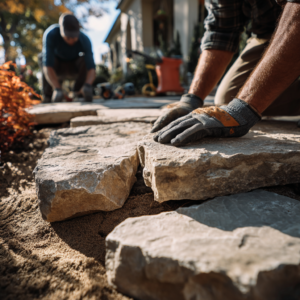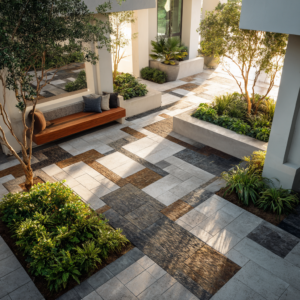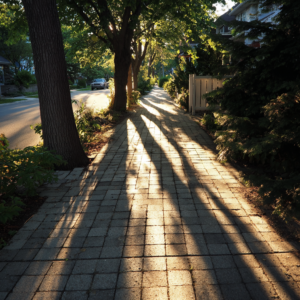As hardscape professionals, our team has spent decades transforming backyards from ordinary to extraordinary. What I’ve learned is simple: choosing between types of backyard flooring is not trivial, and much more complex than people initially think.
But with so many types of backyard flooring available, how do you choose? Well, no worries: let’s walk through your options together, balancing practicality, beauty, and longevity.
You may also like: What is hardscape design? The secret to a beautiful outdoors
Jump to:
Types of backyard flooring for all your outdoor needs
Your flooring choice sets the stage for every memory made outdoors: whether it’s children chasing fireflies, summer barbecues with friends, or quiet mornings with coffee, the surface underfoot influences everything, from safety and comfort to aesthetics and maintenance. That’s why we’ve prepared for you a nice, versatile list of top-quality hardcape materials, with paving stones as the main protagonist.
Concrete Pavers

Concrete pavers are the unsung heroes of outdoor surfaces. The most modern option can mimic pricier materials like stone or brick while offering unbeatable durability. For high-traffic areas around pools or outdoor kitchens, its resistance to fire and corrosion makes it pragmatic.
But it’s not without flaws. Unsealed concrete can crack over time, and its hard surface can feel unforgiving underfoot. In my projects, I often combine it with softer elements, like integrated gravel borders or composite deck tiles, to add warmth and texture.
- Pros: Extreme longevity (30+ years), low cost, fire-resistant, highly customizable.
- Cons: Can crack in freeze-thaw cycles, hard on joints, plain gray looks industrial without upgrades.
Natural Stone

Nothing rivals the organic beauty of flagstone, slate, or travertine. Each piece is unique, offering earthy colors and natural slip resistance, ideal for rainy climates or pool surroundings. Stone’s thermal mass also keeps it cooler than concrete in scorching summers.
However, professional installation is key. For example, one of the most common problems that can arise from a bad installation is an uneven base, which leads to shifting of the pavers or weeds sprouting between their joints.
To avoid that, I always use geotextile fabric beneath stone pavers and double-check a compacted gravel base to prevent this.
- Pros: Stunning aesthetics, stays cool in heat, naturally slip-resistant.
- Cons: Higher cost, requires professional installation, needs periodic sealing.
Porcelain Tiles
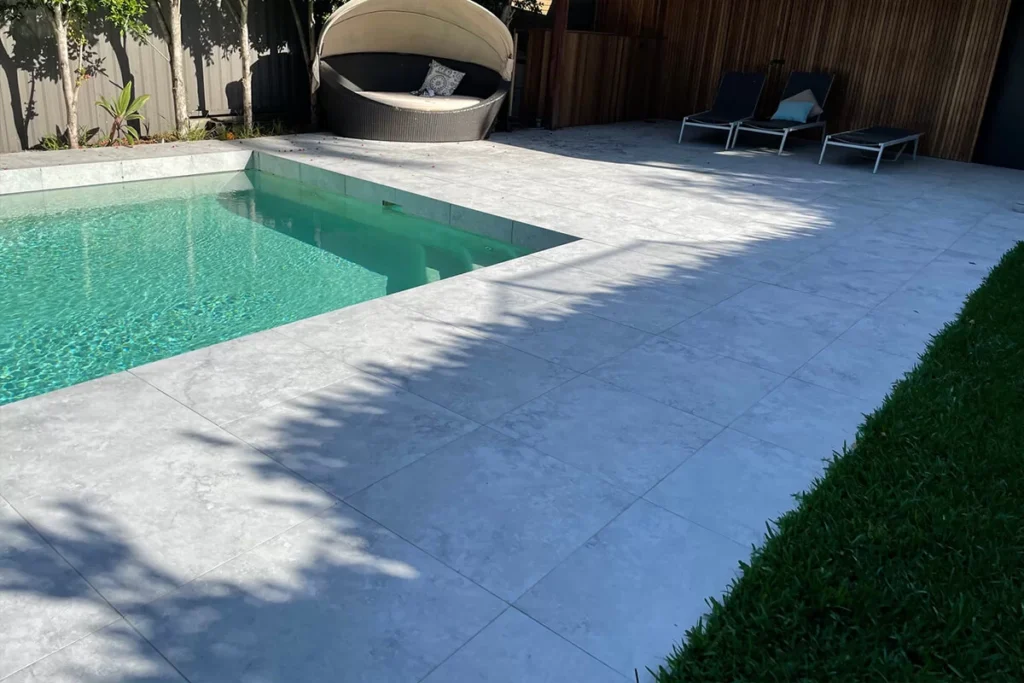
Porcelain has surged in popularity for good reason. Fired at ultra-high temperatures, it resists scratches, stains, and fading better than natural stone or even concrete. Large-format tiles (24″x24″ or bigger) create a seamless, modern look, especially in small urban yards.
The catch? Substrate preparation must be meticulous. Any unevenness risks cracking. I always pair porcelain with flexible mortars and drainage mats, details that separate a lasting installation from a DIY disaster.
- Pros: Near-zero maintenance, versatile designs (mimics wood/stone), fade-resistant.
- Cons: Demands perfect sub-base, slippery when wet if untextured, higher installation cost.
Composite Decking
If you love wood’s warmth but hate annual staining, composite decking is transformative. Made from recycled wood fibers and plastics, it withstands rot, insects, and moisture without splintering. New generations even replicate exotic hardwoods like ipe or mahogany.
However, it costs much more than pavers upfront and can retain heat in direct sun, although going for lighter colors and install tiles with airflow gaps can mitigate heat buildup.
- Pros: No rotting/splintering, low maintenance, eco-friendly (recycled materials).
- Cons: Higher upfront cost, retains heat in sun, can scratch visibly.
Brick Pavers
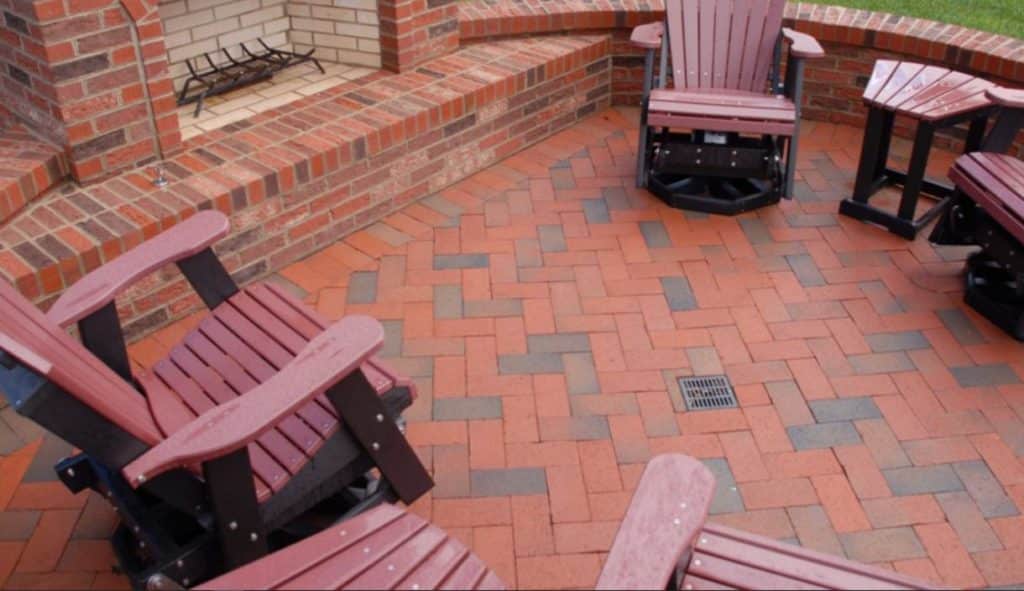
Brick pavers are my personal passion – they carry a legacy, after all. Clay bricks develop a rich patina over time and offer unparalleled structural integrity when laid properly. Their small size allows for intricate patterns (herringbone, basketweave) that hide minor settling.
Plus, they’re sustainable; most contain recycled materials and last 100+ years. The challenge? They require a compacted sand base and periodic joint sand replenishment to prevent weeds.
- Pros: 100+ year lifespan, timeless aesthetics, eco-friendly (recycled content), hides settling.
- Cons: Labor-intensive installation, higher material cost, needs joint sand replenishment.
Gravel & Loose Materials
For organic, permeable solutions, gravel or decomposed granite excels. It’s inexpensive, drains rapidly, and muffles sound, perfect for fire pit seating or garden paths. Modern innovations like “resin-bound gravel” lock stones in place, reducing displacement.
But it should be used strategically. Combine with flagstone stepping stones for stability, or border with steel edging to contain the spread. Just avoid near dining areas; shifting stones frustrate furniture stability.
- Pros: Low cost, DIY-friendly, excellent drainage, natural look.
- Cons: Unstable for furniture, tracks indoors, requires edging/refills.
How to choose your backyard flooring wisely
Over 20+ years, JS Brick has helped clients navigate choices using this 3-step framework:
Step 1: Audit Your Space
- Climate: In freeze-thaw zones? Avoid porous stone (traps water). In hot climates? Skip dark composites (retains heat).
- Traffic: High-use areas (dining zones) need non-slip, stable surfaces (textured porcelain/brick). Low-traffic paths? Gravel saves costs.
- Drainage: Sloped yards? Permeable options (gravel, resin pavers) prevent pooling.
Step 2: Align with Lifestyle
- Time for Maintenance? Busy families → porcelain/composite. Hands-on gardeners → stone/brick (embraces natural aging).
- Aesthetic Goals: Modern → large-format porcelain. Rustic → irregular flagstone. Classic → herringbone brick.
Step 3: Budget Wisely
- Upfront vs. Long-Term: Gravel/concrete = low install cost. Brick/stone = higher initial investment but 50+ year ROI.
- Hybrid Solutions: Combine materials! Example: Brick dining patio + gravel garden path (cuts costs by 30%).
Step 4: Define Your Primary Goal
- Durability → Concrete, Brick, Porcelain
- Low Maintenance → Composite, Porcelain
- Budget-Friendly → Gravel, Stained Concrete
- Aesthetic Impact → Natural Stone, Brick
- Rustic → Flagstone, Decomposed Granite
- Modern → Porcelain, Large-Format Concrete
- Traditional → Brick, Cobblestone

Your flooring, your story
Choosing between the many types of backyard flooring isn’t just about comparing specs, it’s about aligning with your life. Do you host loud pool parties? Slip-resistant porcelain or textured concrete might shine. Crave a woodland retreat? Composite tiles or flagstone blend into nature seamlessly. Prioritize sustainability? Brick and composite decking leverage recycled materials without sacrificing style.
Here at JS Brick, we treat your backyard as a blank canvas. Our team guides you from concept to care, ensuring your floor isn’t just installed, it’s crafted.
So, ready to step into a space that reflects your story? Get in contact today for a free estimate on our services.

